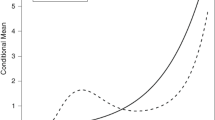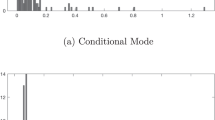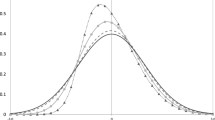Abstract
In this paper we consider a stochastic frontier model in which the distribution of technical inefficiency is truncated normal. In standard notation, technical inefficiency u is distributed as N +(μ, σ 2). This distribution is affected by some environmental variables z that may or may not affect the level of the frontier but that do affect the shortfall of output from the frontier. We will distinguish the pre-truncation mean (μ) and variance (σ 2) from the post-truncation mean μ * = E(u) and variance σ 2* = var(u). Existing models parameterize the pre-truncation mean and/or variance in terms of the environmental variables and some parameters. Changes in the environmental variables cause changes in the pre-truncation mean and/or variance, and imply changes in both the post-truncation mean and variance. The expressions for the changes in the post-truncation mean and variance can be quite complicated. In this paper, we suggest parameterizing the post-truncation mean and variance instead. This leads to simple expressions for the effects of changes in the environmental variables on the mean and variance of u, and it allows the environmental variables to affect the mean of u only, or the variance of u only, or both.

Similar content being viewed by others
Notes
The sign change for ε is needed because he has a cost function with error ε = v + u whereas we have ε = v − u. Changing the sign changes u to −u. It also changes v to −v, but this does not matter when v is normal with mean zero, hence symmetric.
The standard errors for this model, and for the next two models we will discuss, were calculated using the outer product of the gradient (OPG) version of the information matrix. Our attempts to calculate standard errors from the Hessian were not numerically stable, in the sense that small changes in starting values or details of the maximization led to small changes in the parameter estimates and in the likelihood values, but to substantial changes in the Hessian and the resulting standard errors. This did not occur with the OPG estimates.
A technical detail is that in practice we would evaluate the APE at the sample average value of \(\widehat{\mu }_{*}\) not \(\mu_{*}\) (or \(\widehat{\sigma }_{*}\) not \(\sigma_{*}\)). However, due to the extra level of averaging, the order in probability of (average value of \(\widehat{\mu }_{*}\) minus average value of \(\mu_{*}\)) is smaller than the order in probability of (\(\widehat{\gamma } - \gamma\)). This implies that we can treat the average value of \(\widehat{\mu }_{*}\) (or \(\widehat{\sigma }_{*}\)) as a constant in calculating an asymptotic standard error for the APE.
The partial effects of the \(z_{j}\) on \(\mu_{*}\) and \(\sigma_{*}^{2}\) are given by Wang (2002), pp. 244–245. To calculate the partial effect on the standard deviation \(\sigma_{*}\) we note that \(\frac{{d\sigma_{*}^{2} }}{dz} = 2\sigma_{*} \frac{{d\sigma_{*} }}{dz}\) and therefore \(\frac{{d\sigma_{*} }}{dz} = \frac{1}{{2\sigma_{*} }}\frac{{d\sigma_{*}^{2} }}{dz}\).
For the same reason given in footnote 3, we can treat the average values of \(\widehat{\mu }_{*}\) and \(\widehat{\sigma }_{*}\) as constants in calculating the asymptotic standard errors.
The fact that we have v + u instead of v − u is inconsequential. There are just a few sign changes in the likelihood.
References
Aigner DJ, Lovell CAK, Schmidt P (1977) Formulation and estimation of stochastic frontier production function models. J Econ 6:21–37
Alvarez A, Amsler C, Orea L, Schmidt P (2006) Interpreting and testing the scaling property in models where inefficiency depends on firm characteristics. J Prod Anal 25:201–212
Barrow DF, Cohen AC Jr (1954) On some functions involving the mills ratio. Ann Math Stat 25:405–408
Battese GE, Coelli TJ (1995) A model for technical inefficiency effects in a stochastic frontier production function for panel data. Empir Econ 20:325–332
Bera AK, Sharma SC (1999) Estimating production uncertainty in stochastic frontier production function models. J Prod Anal 12:187–210
Caudill SB, Ford JM (1993) Biases in frontier estimation due to heteroskedasticity. Econ Lett 41:17–20
Caudill SB, Ford JM, Gropper DM (1995) Frontier estimation and firm-specific inefficiency measures in the presence of heteroskedasticity. J Bus Econ Stat 13:105–111
Coelli TJ, Rao DP, O’Donnell CJ, Battese GE (2005) An introduction to efficiency and productivity analysis, 2nd edn. Springer
Greene WH (2012) Econometric analysis, 7th edn. Pearson
Horrace WC (2014) Moments of the truncated normal distribution. J Prod Anal. doi:10.1007/s11123-013-0381-8
Huang CJ, Liu J-T (1994) Estimation of a non-neutral stochastic frontier production function. J Prod Anal 5:171–180
Just RE (1975) Risk aversion under profit maximization. Am J Agric Econ 57:347–352
Just RE, Pope RD (1979) Production function estimation and related risk considerations. Am J Agric Econ 61:276–284
Just RE, Pope RD (2003) Agricultural risk analysis: adequacy of models, data, and issues. Am J Agric Econ 85:1249–1256
Kumbhakar SC, Sun K (2013) Derivation of marginal effects of determinants of technical inefficiency. Econ Lett 120:249–253
Kumbhakar SC, Ghosh S, McGuckin JT (1991) A generalized production frontier approach for estimating determinants of inefficiency in U.S. dairy farms. J Bus Econ Stat 9:279–286
Reifschneider D, Stevenson R (1991) Systematic departures from the frontier: a framework for the analysis of firm inefficiency. Int Econ Rev 32:715–723
Stevenson RE (1980) Likelihood functions for generalized stochastic frontier estimation. J Econ 13:57–66
Wang H-J (2002) Heteroscedasticity and non-monotonic efficiency effects of a stochastic frontier model. J Prod Anal 18:241–253
Wang H-J, Schmidt P (2002) One-step and two-step estimation of the effects of exogenous variables on technical efficiency levels. J Prod Anal 18:129–144
Author information
Authors and Affiliations
Corresponding author
Electronic supplementary material
Below is the link to the electronic supplementary material.
Rights and permissions
About this article
Cite this article
Amsler, C., Schmidt, P. & Tsay, WJ. A post-truncation parameterization of truncated normal technical inefficiency. J Prod Anal 44, 209–220 (2015). https://doi.org/10.1007/s11123-014-0409-8
Published:
Issue Date:
DOI: https://doi.org/10.1007/s11123-014-0409-8




